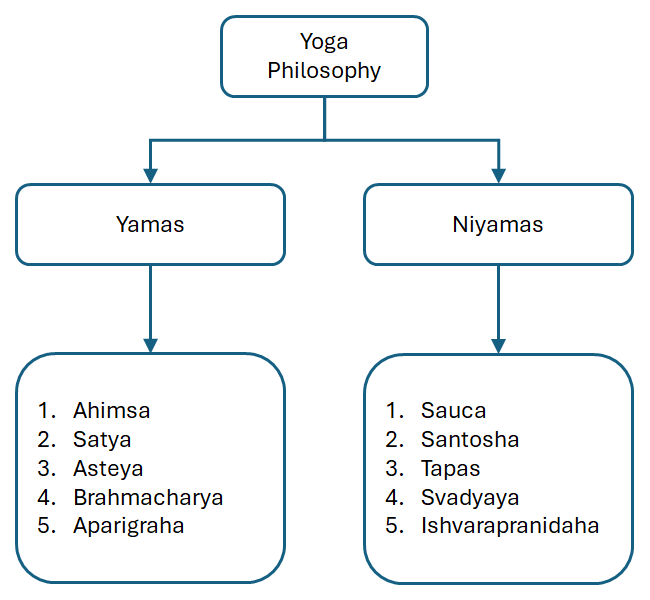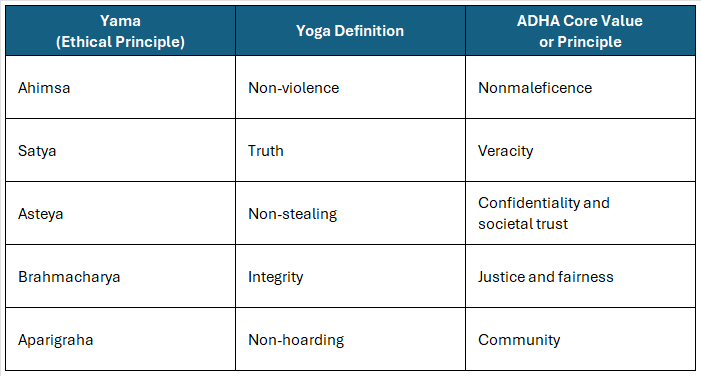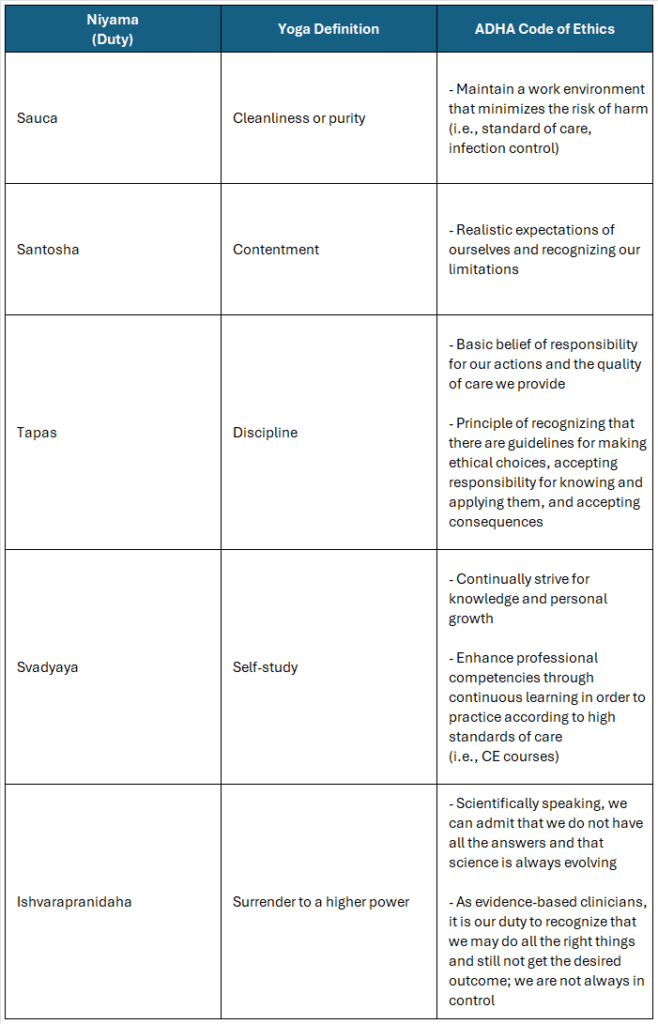“Now is the time for yoga.”1 This is a rough translation of the very first words of Patanjali’s Yoga Sutras, a two-thousand-year-old text describing the ancient yoga philosophy.1
Yoga, as we know it today, has been adapted to the demands of Western society. But, at its core, yoga remains founded in cultivating the mind-body connection, self-awareness, and adopting a healthy lifestyle. Yoga reduces cortisol, lowers blood pressure, improves circulation, aids in the improvement of chronic pain, and induces positive feelings of well-being.2
Dental hygienists are among the few clinical health professionals specializing in disease prevention, making adopting this preventative modality ideally suited for dental hygienists.
Why yoga?
Yoga stands apart from other forms of exercise for various reasons. A notable year-long study conducted in 2015 involved 220 male and female dentists between ages 30 and 70, each with a minimum of eight years of clinical practice and work weeks that were at least 30 hours long. The findings showed that yoga was more successful at reducing musculoskeletal pain than other methods of exercise, like brisk walking, jogging, or aerobics.3
Kothari and Kumar found that the intentional movements and conscious observation of the breath and mind that occur as the practitioner moves through the yoga poses have the potential to facilitate stress management and wellness in college students. Yoga has been shown to positively influence well-being and quality of life in addition to measurable physiological benefits such as improved lung capacity, immunity, endocrine activity, gastrointestinal regularity, resting heart rate, and blood pressure.2
The uniqueness of yoga was noted by Braun and colleagues, who examined yoga interventions in dental or dental hygiene school curricula. Yoga stood apart due to its ease of accessibility, brevity, low cost, and unique potential for being easily incorporated into dental school or dental hygiene school academic programming.4
A large component of what makes a 20-minute or one-hour yoga class so effective at reducing stress and calming the nervous system has largely to do with how we train our minds to react to new and uncomfortable situations or feelings through the challenges presented during the class.
Philosophy of Yoga and the American Dental Hygienists’ Association Code of Ethics
Practicing yoga is more than showing up on the mat and performing a series of controlled poses or asanas. The philosophy of yoga contains a list of yamas (ethical principles) and niyamas (duties), which align well with the ethical principles and core values dental hygienists adhere to as health professionals.5
The yamas and niyamas are each broken down into five specific categories, as seen in the flow chart below.5

Adapted from Dylan & Muncaster, ADHA Bylaws and Code of Ethics5,6
The following three tables show how the yogic ethical principles and moral duties align with the ethical principles and values of dental hygiene, beginning with the definitions of yama and niyama. Listed next to the description of the principle or duty as it pertains to yoga is the corresponding American Dental Hygienists’ Association (ADHA) core value, principle, or professional standard.6

Adapted from Dylan & Muncaster, ADHA Bylaws and Code of Ethics5,6

Adapted from Dylan & Muncaster, ADHA Bylaws and Code of Ethics5,6

Adapted from Dylan & Muncaster, ADHA Bylaws and Code of Ethics5,6
Signs and Symptoms of Burnout
Dental hygienists are licensed health care providers who often assume multiple roles throughout a single appointment and must be able to quickly adapt professionally to different personalities and situations that arise.7 Dental hygienists have identified chronic workplace stressors such as time constraints, lack of self-sufficiency and scheduling control when it comes to patient appointments, stressful interprofessional relations within the dental team, and the physical pain of performing repetitive clinical work.8
Researchers highlight the importance of mitigating burnout to protect the dental hygienist and the patient. If the progression of burnout is not halted, the unresolved stressors can initiate a chronic state of “fight or flight” response, which can increase the risk of endocrine, cardiovascular, neural, gastrointestinal, musculoskeletal, sleep, and psychological disorders. Chronic stress and prolonged burnout can be a predictor of an increased mortality rate among those younger than 45 and may trigger post-traumatic stress disorder (PTSD), addiction, and depression in sufferers.8
Clinicians suffering from the effects of burnout will likely not be able to deliver the same quality of care, which can lead to a decrease in job performance and possible patient harm. Interestingly, individuals who tend to be more likely to experience burnout include perfectionistic, highly ambitious, and type A personalities who have difficulty delegating tasks.8
The link between chronic workplace stress and burnout is examined as a progression of four phases that constitute emotional exhaustion, depersonalization or cynicism, and feelings of personal accomplishment:9
- The first phase described is an overwhelming feeling of emotional and physical exhaustion, with the clinician beginning to become detached from parts of their job.
- The second phase is marked by an increase in cynicism and a sense of detachment from patients, leading to the clinician becoming satisfied with performing the bare minimum.
- The third phase is characterized by a loss of self-confidence and a lack of personal accomplishment.
- The fourth phase of burnout syndrome in dental hygiene occurs when there is a noticeable decline in overall mental and physical health, as well as a development of addiction, depression, and suicide in some cases.
Burnout syndrome has not been well documented specifically among licensed dental hygienists. However, an emerging trend suggests that dental hygiene students are susceptible to these afflictions.9 A study conducted in 2018 on burnout in dental and dental hygiene students found that 22% of dental hygiene students reported feelings of cynicism and emotional exhaustion.4 Many researchers emphasized the importance of introducing stress management techniques and positive coping strategies as an essential element to the education of future dental hygienists.4,7-14
However, the Commission on Dental Accreditation (CODA) for dental hygiene programs does not include any course requirements that allow students the opportunity to learn how to manage a physically and psychologically demanding career.15,16 The demand for dental hygienists is at an all-time high, yet it is reported that 38% of dental hygiene students are already showing evidence of burnout.4
The dental hygiene profession permanently lost roughly 3,300 working dental hygienists after the COVID-19 pandemic, according to an American Dental Association report published in February of 2022.17 Approximately one-third (36.2%) of practicing dental hygienists reported symptoms of burnout and over half (65%) of respondents scored high in emotional exhaustion according to the surveys conducted utilizing the Maslach Burnout Inventory Human Services Survey for Medical Personnel.8
Now is the time for yoga.
Physiological Effects of Burnout
The dental hygiene career field is projected to grow by 7%, and with increased demand comes an increased workload and higher expectations from patients and business owners.18 Dental hygienists are in a unique position to recognize early signs of oral disease, the beginning stages of oral cancer, and early signs and symptoms of systemic diseases and conditions that might otherwise go unnoticed by a patient’s primary care provider.
Dental hygiene is a career field with flexibility in scheduling and the freedom to work in many different clinical settings. However, there are physiological, psychological, and physical effects of this stressful career that dental hygienists should work to minimize to have career longevity and job satisfaction.8
Not all stress is destructive to the human body, although chronic stress can lead to hormonal imbalances and inflammation that have the potential to disrupt a wide variety of bodily mechanisms, such as endocrine and autonomic systems. Research published in the International Journal of Yoga reported that stress is a contributing factor in 75% to 90% of all chronic diseases, and reduction must be incorporated into daily life depending on individual stressors.10
Chronic stress has a significant impact on the immune system, cardiovascular system, neuroendocrine system, and central nervous system.10 Stress hormones such as cortisol, catecholamines, and pro-inflammatory cytokines, such as interleukin-6, tumor necrosis factor, and C-reactive protein, are elevated in response to chronic stress.10,19
Chronic stress can also affect the shape and function of the brain, and this may result in irreversible damage to brain cells, which can occur from the overproduction of pro-inflammatory cytokines and eventual imbalance in the body’s ability to regulate the anti-inflammatory response.10
There is biochemical evidence that practicing yoga reduces the inflammatory responses associated with stressful events.19 According to an outpatient study conducted utilizing 58 healthy hospital staff members diagnosed with major depression, it was reported that all participants who practiced yoga with or without medications saw a significant decrease in serum cortisol levels in comparison to no significant change seen in those participants who received medication only.20
Another study conducted in 2016 on 40 healthy medical student volunteers reported similar findings after students practiced yoga for 60 minutes daily for three months. There was a statistically significant drop in salivary cortisol in the test group compared to the control group, which showed no statistically significant change in salivary cortisol levels.21
Physical Effects of Burnout
In addition to the increased systemic inflammatory response, dental hygienists must cope with the physical pains accompanying chronic distress. The three most common areas of pain reported by dental hygienists are the neck, shoulder, and upper and lower back.11
In a two-year study conducted in 2017 on the effects of yoga on musculoskeletal pain, dental hygienists who routinely incorporated complementary health approaches into their daily lives, such as acupuncture, Ayurveda, chiropractic care, massage, meditation, and yoga claimed an ability to work more hours, superior career satisfaction, greater career longevity, and enhanced overall health and well-being. It was noted in this study that chronic musculoskeletal pain caused dental hygienists to work fewer hours and eventually leave the profession.11
Furthermore, dental hygiene students who practiced yoga for one hour twice a week reported significantly less pain compared to the control group, which was instructed to continue their normal physical fitness routines. There was a significant reduction in back pain reported by practicing yoga as little as once a week, and most studies show an overall improvement in well-being and reduction of depression and stress, demonstrating yoga’s merit as an alternative approach to burnout syndrome.11
Psychological Effects of Burnout
Psychological stress does not just affect our mental well-being. It can alter insulin production, which can lead to diabetes and gastric upset that can result in peptic ulcers and other gastrointestinal-related issues.10 One of the key elements of combating burnout syndrome through regular yoga practice is its effect on compassion, resilience, and emotional well-being.22
Studies have shown that regular yoga practice helps to improve self-compassion and self-care practices. This improvement in self-compassion also positively impacted participants’ mental and physical health, which is negatively associated with burnout syndrome. One of the most reported benefits of regular yoga practice was the reduction in stress and anxiety.13
Limitations and Contraindications to Yoga
Many of the studies mentioned in this review utilized convenience samples and self-reported surveys, and answers might have been affected by the participant’s knowledge of the study topic.4,8,9,13 The participants were also predominately female, leaving the possibility that the effects of the yoga intervention could have gender-specific influences.4,8,11
Adverse effects were reported regarding complex yoga poses being practiced by novice practitioners, as yoga has the potential to cause injuries if performed incorrectly or without adequate instruction or modification by an experienced yoga instructor.16 Yoga movements should never be painful, and the limitations of the practitioner should always guide the practice of yoga.
In Closing
From their first day in dental hygiene school, students are taught to look at each patient as a whole person and consider everything from their daily oral hygiene routine to how they take their morning coffee. In recent years, the medical field has evolved to a more patient-centered approach in health care delivery. Yet, it seems we have forgotten about the professionals who deliver this highly specialized care.
The application of daily yoga and relaxation techniques into the practicing clinician’s schedule is not only necessary to ensure a long career in practice and patient safety, but it is affordable, practical, and effective.
Before you leave, check out the Today’s RDH self-study CE courses. All courses are peer-reviewed and non-sponsored to focus solely on high-quality education. Click here now.
Listen to the Today’s RDH Dental Hygiene Podcast Below:
References
- Leggett, T. (2016). Sankara on the Yoga Sutras: A Full Translation of the Newly Discovered Text. Motilal Banarsidass.
- Kothari, A., Kumar, K. Physiological Benefits of Yoga for College Students. International Journal of Yoga and Allied Sciences. 2022; 11(1): 70-76. https://indianyoga.org/wp-content/uploads/2022/04/v11-issue1-article9.pdf
- Koneru, S., Tanikonda, R. Role of Yoga and Physical Activity in Work-Related Musculoskeletal Disorders Among Dentists. Journal of International Society of Preventive and Community Dentistry. 2015; 5(3): 199-204. https://www.ncbi.nlm.nih.gov/pmc/articles/PMC4515802/
- Braun, S.E., Deeb, G., Carrico, C., Kinser, P.A. Brief Yoga Intervention for Dental and Dental Hygiene Students: A Feasibility and Acceptability Study. Journal of Evidence-Based Integrative Medicine. 2019; 24: 2515690X19855303. https://www.ncbi.nlm.nih.gov/pmc/articles/PMC6580712/
- Dylan, A. Muncaster, K. The Yamas and Niyamas of Ashtanga Yoga: Relevance to Social Work Practice. Journal of Religion and Spirituality in Social Work: Social Thought. 2021; 40(4): 420-442. https://www.tandfonline.com/doi/full/10.1080/15426432.2021.1912686
- ADHA Bylaws and Code of Ethics. (2023, June). American Dental Hygienists’ Association. https://www.adha.org/wp-content/uploads/2024/06/ADHA-Bylaws_Code-of-Ethics-FY23.pdf
- Shivakwnar, K., Shivakwnar, V., Chandu, G. Yoga and Professional Burnout in Dentistry. Journal of Indian Association of Public Health Dentistry. 2008; 6(11): 41-45. https://journals.lww.com/aphd/abstract/2008/06110/yoga_and_professional_burnout_in_dentistry.12.aspx
- Haslam, S.K., Wade, A., Macdonald, L.K., et al. Burnout Syndrome in Nova Scotia Dental Hygienists During the COVID-19 Pandemic: Maslach Burnout Inventory. Canadian Journal of Dental Hygiene. 2022; 56(2): 63-71. https://www.ncbi.nlm.nih.gov/pmc/articles/PMC9236299/
- Bercasio, L.V., Rowe, D.J., Yansane, A.I. Factors Associated With Burnout Among Dental Hygienists in California. Journal of Dental Hygiene. 2020; 94(6): 40-48. https://jdh.adha.org/content/jdenthyg/94/6/40.full.pdf
- Venkatesh, H.N., Ravish, H., Silvia, C.W.D., Srinivas, H. Molecular Signature of the Immune Response to Yoga Therapy in Stress-Related Chronic Disease Conditions: An Insight. International Journal of Yoga. 2020; 13(1): 9-17. https://www.ncbi.nlm.nih.gov/pmc/articles/PMC6937878/
- Monson, A.L., Chismark, A.M., Cooper, B.R., Krenik-Matejcek, T.M. Effects of Yoga on Musculoskeletal Pain. Journal of Dental Hygiene. 2017; 91(2): 15-22. https://pubmed.ncbi.nlm.nih.gov/29118252/
- Kinser, P., Braun, S., Deeb, G., et al. “Awareness Is the First Step”: An Interprofessional Course on Mindfulness and Mindful-Movement for Healthcare Professionals and Students. Complementary Therapies in Clinical Practice. 2016; 25: 18-25. https://www.sciencedirect.com/science/article/abs/pii/S1744388116300603
- Ciezar-Andersen, S.D., Hayden, K.A., King-Shier, K.M. A Systematic Review of Yoga Interventions for Helping Health Professionals and Students. Complementary Therapies in Medicine. 2021; 58: 102704. https://doi.org/10.1016/j.ctim.2021.102704
- Alire, E., Brems, C., Bell, K., Chismark, A. The Role of Yoga in Treating Stress-Related Symptoms in Dental Hygiene Students. International Journal of Yoga. 2020; 13(3): 213-222. https://www.ncbi.nlm.nih.gov/pmc/articles/PMC7735503/
- Accreditation Standards for Dental Hygiene Programs. (2023, August 11). Commission On Dental Accreditation. https://coda.ada.org/-/media/project/ada-organization/ada/coda/files/dental_hygiene_standards.pdf
- Nishat, R., Bhuyan, L., Nezam, S., et al. The Precedence and Viability of Yoga in the Lives of D3-Dental Students, Dental Practitioners, and Dental Patients. Journal of Family Medicine and Primary Care. 2019; 8(12): 3808-3813. https://www.ncbi.nlm.nih.gov/pmc/articles/PMC6924249/
- Rappé, J., Hoeft, E. (2022, February 22). Research Reveals Impact of COVID-19 on Dental Hygienists. American Dental Association. https://www.ada.org/en/about/press-releases/research-reveals-impact-of-covid-19-on-dental-hygienists
- Occupational Outlook Handbook: Dental Hygienists. (2024, April 17). U.S. Bureau of Labor Statistics. https://www.bls.gov/ooh/healthcare/dental-hygienists.htm
- Harkess, K.N., Ryan, J., Delfabbro, P.H., Cohen-Woods, S. Preliminary Indications of the Effect of a Brief Yoga Intervention on Markers of Inflammation and DNA Methylation in Chronically Stressed Women. Translational Psychiatry. 2016; 6(11): e965. https://www.nature.com/articles/tp2016234
- Thirthalli, J., Naveen, G.H., Rao, M.G., et al. Cortisol and Antidepressant Effects of Yoga. Indian Journal of Psychiatry. 2013; 55(Suppl 3): S405-408. https://www.ncbi.nlm.nih.gov/pmc/articles/PMC3768222/
- Pandley, P., Singh, V., Devesh, Haider, J. Effect of Yoga on Salivary Cortisol in Medical Student. International Journal of Research in Medical Sciences. 2016; 4(11): 4995-4998. https://www.msjonline.org/index.php/ijrms/article/view/264/264
- Ofei-Dodoo, S., Cleland-Leighton, A., Nilsen, K., et al. Impact of a Mindfulness-Based, Workplace Group Yoga Intervention on Burnout, Self-Care, and Compassion in Health Care Professionals: A Pilot Study. Journal of Occupational and Environmental Medicine. 2020; 62(8): 581-587. https://doi.org/10.1097/JOM.0000000000001892











